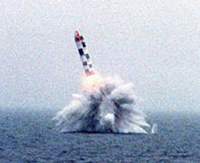Strategic submarine of new generation to be finished soon in Russia
According to shipbuilding.ru, a joint project of the Agency of Informational Resources and the Krylov Research Institute, on April, 15 Sevmash Shipyard will take out of the slipway the new generation strategic submarine Yuri Dolgoruky. Two more subs of the same 955 project Borei are at different stages of construction. The new subs will carry a new generation intercontinental missile Bulava (mace). According to the Russian designers it will take the foreign competitors 10-15 years to make something similar with close characteristics. It is true that the process of creating this missile is experiencing certain difficulties, which is willingly quoted by the foreign observers. However, even with all failures the no-match weapon is likely to be created in no-match short terms.

The last (third) test of Bulava held on December, 24 was not fulfilled completely. The missile burst over the Sea of Okhotsk within a reasonably short distance before the target. According to the official sources a technical malfunction occurred in the 3rd stage engine and this is why the missile could not follow trajectory, whereby it should have flown up to the test filed Kura in Kamchatka peninsula. The first and second stages of Bulava "worked perfectly", but there were "certain drawbacks" in the third stage.
The missile started from the test submarine Dmitry Donskoj, which was in a surface position in the White Sea. On October, 25 Bulava was launched from the same sub in a submarine position. The missile flew about 200 seconds and started to change the trajectory, after which the alarm system commanded self-destruction. At that time the reaction of the Russian official institutions was surprisingly calm. There were even unofficial phrases that the launch is regarded as successful. The first out of three failures took place on Sept, 7. All above gave enough ground for the ill-wishers to speak about certain regularity: in two launchings from a submarine position (on September, 7th and on October, 25th, 2006) the rocket fell in the first minutes of the flight, whereas in two other from a surface position (on September, 27th 2005 and on December, 24th, 2006) the problems occurred in the third stage.
It turns out that journalists and specialists view the same point differently. According to the lower rank engineers (probably the most unbiased source) such failures may not be regarded as a mistake of the subs’ crew or a serious failure of the machinery. This is a standard test work and certain deviations may be even forecasted. According to one of the former senior officers of the Central Military-Naval Test Filed near Severodvnsk while the individual units of a complex are adjusted to one another such events can be regarded as “working procedure”. The average historical number of failures of this level according to the statistics is vividly lower in Russia (USSR) than in the USA. The malfunctions of Bulava did not reach “a level of concern” at all. Maximum what the skeptics can state at the moment is that the designers failed with the claimed “stainless” tests.
It is out of the question to expect any changes of the attitude on the official level. Topol (successfully implemented ground based version of the missile) and Bulava programs will not be reconsidered. It goes without saying. For example, the head of the Russian Space Agency Anatoly Perminov considers that "nothing terrible took place", as it was only the fifth test of Bulava and with each launch of the missile its characteristic improve. Besides, to commission a missile complex, according to Mr. Perminov, 12-14 start-up tests are required on average.
The reason for such a hurry with the development of the new missile is that the designers try to save the costs of commissioningthemissile.Accordingto the head of the Moscow Institute of Teplotechnika (MIT) Yuri Solomonov the unification of the ground based missiles gave the economization of about 30%, the unification with the naval missiles will further cut costs. In this case the designers have full understanding from the government and the military-industrial commission. They agreed that Bulava must be made at the same plants as Topol-M (Votkinsky Plant). When the manufacturer got the first orders for test Bulavas in 2004-2005 its costs immediately went down.
According to the different open sources the new hard fueled Bulava is 11,5m long (without warhead, with – 12.1m), its maximum diameter is 2m, launching weight - 36,8t. The length of the container is 12.1m, diameter - 2,1m. The first 3.8m long stage weighs 18.6t. The information on the second and third stages has not been released. All stages have the diameter of 3m. The payload is 1150kg, the declared number of warheads – 6, which have the accuracy of 350m. According to other sources there are 10 warheads and the range is at least 8000km. It is certain that the missile has the hypersonic maneuvering warheads capable of changing the trajectory vertically and horizontally, which can penetrate any existing and perspective strategic defense system.
The experts called this new trajectory “quasi-ballistic”. According to the general-colonel Nikolay Solovtsov, the commander of the Russian Strategic Missile Forces, creation of the rockets with changeable trajectory and hypersonic speed is a matter of the next couple of years, not a long-term future. But even today Russian missiles now on duty can hit any target anywhere in the world. The factor of technical readiness of these weapons is 0,97-0,98. It means that out of each hundred 97-98 missiles can immediately and successfully fulfill a mission. As an example the commander referred to the last year's exercise, when the missile "Topol" confirmed combat efficiency after a 90-kilometer raid. However, Russian designer improve not only the strike power.
In 2006 t he Presidium of the Russian Academy of Sciences held the meeting dedicated to the report “How to pass through the Anti Missile Defense”. The speakers arrived at the conclusion that it is technically possible to guarantee the penetration through the strategic missile defense. The main report was presented by the designer of the Topol and Bulava Yuri Solomonov. He pointed out the changing policy of the development of the strategic forces. In the cold war era 40% of the strike efficiency accounted for the informational support, 60% for the strike power. Today the 40:60 ratio is counted vise versa and the trend continues.
This is way the designers try to hide the launchings and increase the survivability of the missiles along the whole route. The reason why Russia invests in the ground mobile Topols and naval Bulavas is because the US plans to start from 2009 the systems of space monitoring of earth. Mobile complexes could guarantee 80% launchings. According to Yuri Solomonov the tests demonstrated that Topols’ launchings remained unnoticed. Also the new on-board equipment of Topols is highly resistant to the interception means, including nuclear and laser. Today having shorted the take off stage, the designers are working on reducing the visibility of the missile at the stage of splitting the warheads and making it more difficult to tell the false warheads from the real ones. According to Mr. Solomonov the unified missiles Topol-M and Bulava shall be the core of the Russian nuclear deterrence till 2040-2045 and keeping in mind the modernization potential probably till 2050-2060. Yuri Solomonov publicly wanted to forecast that the nearest foreign matches will appear in 15-20 years.
Yuri Seleznyov
Pravda.ru
Join Pravda.ru forum to discuss this article
Subscribe to Pravda.Ru Telegram channel, Facebook, RSS!


